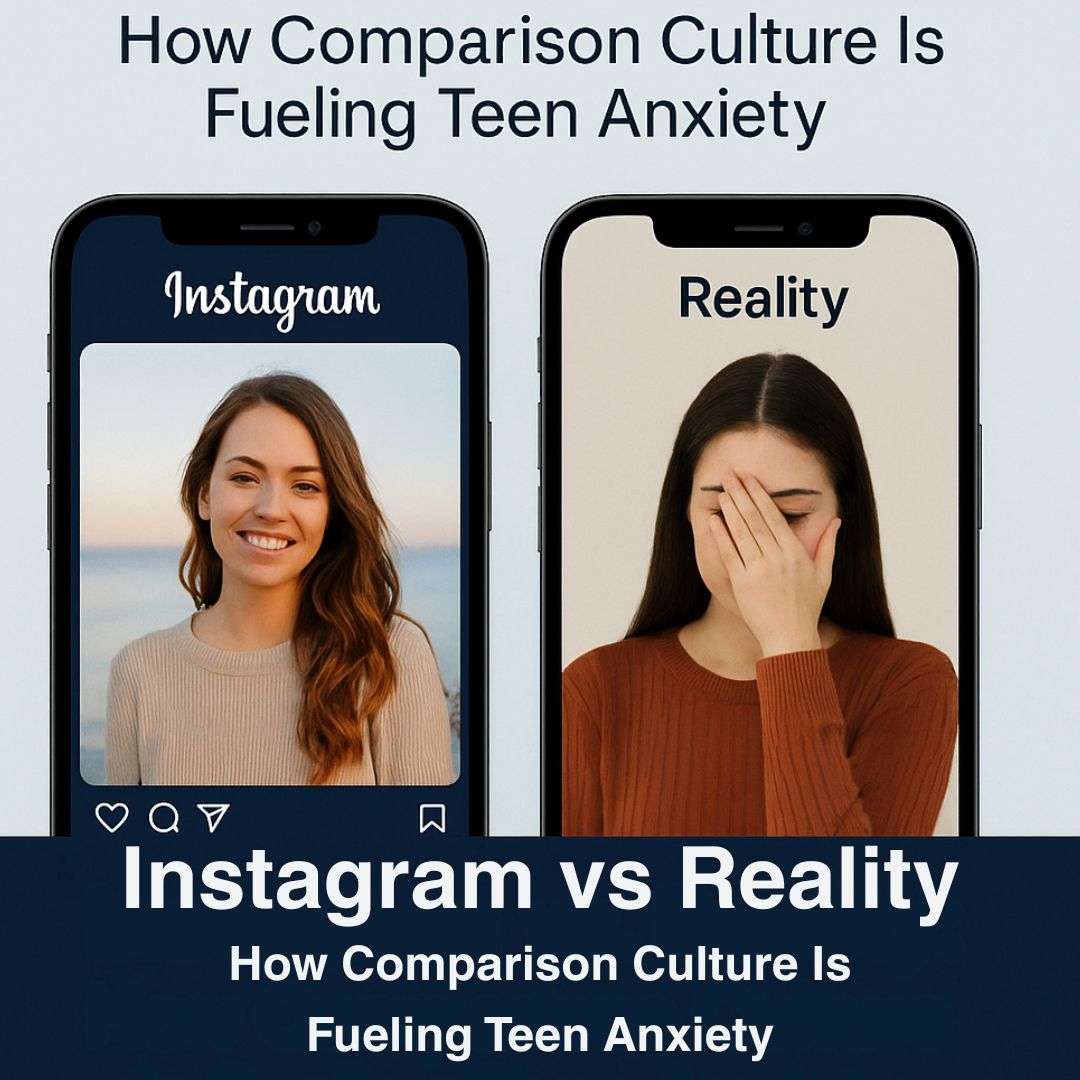How Instagram Fuels Anxiety and Body Image Issues in Teens

June 13, 2025
Instagram vs. Reality: The Role of Social Comparison in the Increase of Anxiety Among Teens
The state of teenager's mental health is increasingly concerning, especially considering that it may be linked to something as common as a smartphone. With the access provided by smartphones, social media platforms such as Instagram are now accessible 24 hours a day, which has resulted in an increase in anxiety for teenagers. The curated lives showcased online—selfies, vacations, and fitness achievements—are now unhealthy benchmarks that are shattering the minds of the youth.Social comparison tends to be a phenomenon that stems from behaviorally ingrained in humans. In the case of adolescents, the phenomenon has been heightened due to Instagram’s influence, making it more vivid, immediate, and intense. The impact Instagram has on teenagers' mental health has become a pressing issue for psychologists, educators, and parents, all concerned about the reasoning and consequences of using such a platform.
The European Journal of Communication published an article which defined Instagram as an editor of users’ lives. This observation seems to capture the very crux of the issue discussed—the comparison culture we now live in. However, this culture does not arise out of societal pressure; it emerges as a result of ego and the lack of self-worth. Such tendencies were once limited to friends and relatives, but now it has expanded beyond that. Social Media's Impact on Teen Anxiety from a Psychological Perspective
What Causes Anxiety in Teenagers?
Teens are coping with an emotional and hormonal whirlwind, schoolwork, and peer pressure. Combine that with the constant need to maintain a social media profile, and you’ve got the perfect recipe for anxiety.- Here are some common symptoms of anxiety in teenagers:
- Increased Restlessness and Agitation After Scrolling
- Changes in Sleep Patterns Due to Excessive Screen Time at Night
- Fear of Not Meeting Social Media Engagement Expectations
- Engagement in Avoidance Behavior Due to Fear of Not Meeting Social Media Standards
How Validation is Processed by the Brain
Consider Instagram as a digital gambling hub. Each notification serves as a lever to a slot machine and triggers a surge of dopamine. Will your new post be liked? Did someone drop a compliment? When the rewards do not show, the expectation crashes hard.Neuroscience indicates that social validation, especially during adolescence, activates the brain's reward system. Adolescents become conditioned to seek digital rewards like likes, views, and follows. The fear of not being "seen," as in not receiving attention online, can trigger a chronic stress response akin to social rejection, which is harmful in real life.
Comparison and Social Media Formulation: the Teen Identity Issue
Instagram has become a trap for self-comparison.
Teens are scrolling through highly curated images from both their peers and influencers. This leads them to introspect deeply about their own self-worth. Unlike a decade ago, when comparison was done on a small scale, Instagram has amplified it on a much larger level. The outcome of such a phenomenon can lead to emotional exhaustion, continuous envy, and a sense of never being satisfied with oneself.Even what would ordinarily be considered dull—studying, for instance—becomes worse when juxtaposed against someone else’s edited version of their day. Teens might begin asking themselves questions such as, “Why does my life feel so boring?” or “Why don’t I look like that?” forgetting that they are not viewing the full reality of someone else's life—just edited bits.
The Effects of Curated Content on Teen Self-Image
To a typical Instagram-using teenager, “Instagram isn’t real life” is meaningless. A 14-year-old girl scrolling through her feed and seeing classmates with six packs, perfect skin, and enjoying luxury vacations wouldn’t dream of skipping over those posts. Those are not chance captures – they fall under the category of curated content made with maximized admiration in mind. Such content alters the perception of teens far more than we anticipate.Things like filters, photo lighting, and picture editing software like “Facetune” make the task of matching unrealistic standards much easier. While many teens acknowledge the fact that their faces are often heavily edited, there is immense pressure to conform to the fragmented version of reality presented. The impact curated content has on us psychologically is especially profound when there is a gap between the fake reality we know and the curated one we are presented with.
Teen Self-Esteem and Instagram: A Shaky Bond
Comments, shares, and DMs have all but replaced tangible measures of self-worth for teenagers. Social media dictates the creation of their identity and sense of self. A post with no engagement? Instant self-doubt. A post that blows up? A spiraling addiction to validation.Such behavior can spur emotional dependency where a teenager’s mood becomes volatile and strictly conditioned by digital endorsement. A worrying sign of deeper self-esteem issues arises when kids delete posts that fail to meet a certain threshold after a short time.
The Adolescent Identity Crisis along with Social Media Influences
Self-discovery is a hallmark of adolescence, but social media acts as an impediment to this process. Rather than uncovering their true selves, adolescents are required to meet an imagined checklist of roles that are expected of them. This results in an identity crisis where self-worth hinges on external approval.The disparity between one’s self and social media persona can result in emotional disconnect, cognitive dissonance, and depression. Adolescents are losing track of the core values that once defined them, their passions, and their personalities due to the need to project a curated identity.
Social Media Influencers Effect on Adolescents
Alluring physiques, copious brand partnerships, and daily doses of inspiration paint a flawless image of life. Perfection is attainable, and adolescents start modeling their lives around this ideal. However, what is concealed is the extensive work that goes into it—photoshoots, scripted content, sponsorships, and heavy Photoshop.Social media influencers seek likes and validation by staging everyday activities; mugs brimming with coffee, “candid” smiles paired with laughter, and “no-makeup” selfies that are meticulously lit. Adolescents fail to achieve these fabricated standards and appear to internalize a sense of inadequacy, which, unbeknownst to them, stems from comparing themselves against a detached version of reality.
The Fear of Missing Out (FOMO) and Lifestyle Envy
FOMO is more than just a term used to define a '90s-era phenomenon. Teenagers today are challenged with the issue of FOMO, where they compulsively check social media, risk going to sleep, and even develop anxiety during fun activities, as their main concern is getting attention for their documentation of the event.Instagram enables self-doubt. “Why is everyone else happier, prettier, more successful than me?” They aren’t. Most people are engaging in the same activity of posing, performing, or polishing their lives for social media.
Instagram and Body Image Issues in Teenagers
Body image and Instagram are two topics that go hand in hand. On Instagram, your feed is filled with gym bodies, waist trainers, and glowing skin which leads to unrealistic expectations and an increasing number of adolescents unhappy with their natural bodies.Even athletic adolescents may feel inadequate for not having the 'perfect' body type portrayed online. This dissatisfaction is linked to increased dieting, use of cosmetic products, and even consideration of plastic surgery at alarmingly young ages.
Social Media and Body Dysmorphia in Teens
Social media and body dysmorphia in teens are a direct relationship. The incessant scrolling leads to an overemphasis on so-called “flaws” that people, including the affected individual, most likely do not notice. This can escalate into a full form of dysmorphia, or eating disorders.Boys get affected too. Instagram together with other social media platforms pushes unrealistic expectations towards shredded bodies or bulking up. There is no escape from body image issues and social media as these narrow-minded ideals are reinforced for everyone.
Unrealistic Beauty Standards and Their Mental Toll
These while set standards add no value, create many issues such as self-harm and eating disorders. Wishing to achieve such abs by the age of 15 and hourglass figures at 12 is not uncommon. It is a beauty arms race that no one succeeds in.To add to the woes, these standards are always changing. The constant trying to keep up with what is “trending” this week and therefore looks, style, and body shape further complicates existing concerns.
👨👩👧 Parenting & Prevention
Assisting Your Teen With Anxiety
Listening is the first step. Invite your teen to share their online experiences and facilitate open dialogue. Avoid asking yes or no questions. Instead, inquire, “What do you feel when you scroll through Instagram?”Your teenager’s feelings must be validated, even when they appear insignificant to you. Feelings like “That’s not real” or “Just ignore it” are both dismissive and unhelpful. Instead, empathize and offer guidance on healthy coping strategies.
Digital Wellness for Teenagers: What Works
Encourage a day free from screens. Utilize apps such as “Moment” or “Freedom” to enforce limits. Actively promote sports, art, and volunteering as in-person alternatives. Digital wellness does not translate to no devices; rather, it refers to balanced usage.An additional effective method is co-scrolling or co-watching. Ask your teen to show you their favorite accounts. This presents opportunities to discuss important topics such as values, identity, and self-worth in a natural setting.
Helping Teens Manage Social Media Pressure
Encourage curating a healthier digital environment. Urge your teen to actively unfollow accounts that make them feel anxious, grief, or self-doubt and seek those that foster positivity. Teach them to put the device down when needed.Reinforcing boundaries is crucial. It is permissible to not post, take a break from replying to DMs, or log off entirely when social media becomes overwhelming.
Advanced Outreach for Teenagers with an Internet Presence
Shifting habits that teenagers have requires a lot more than, “avoid using Instagram.” We must build on a foundation of education. Prepare teenagers on how content is structured, the role of algorithms, and the ease with which things can be digitally fabricated. Once they grasp the “why” behind “what” they view, power is in their hands.Encourage self-reflection by gauging their participation. Ask them how specific pieces of content affect their emotions and what the rationale behind the content’s existence is. Critical thought is paramount.
Analyzing the structure of social media content
Engaging teenagers in an experiment is an effective learning strategy. Ask them to share a selfie without any filters and observe the results. This experiment illustrates the grit and determination required in the creation of “perfect” content.The phrase Instagram vs reality has added contextual depth to a statement. This serves as an illustration of the reality of numerous teenagers. The curated perfection serves as a standard to aspire to while the unending scrutiny leads to influencer envy. If left under the influence of such a culture, youngsters may encounter anxiety, body dysmorphia, identity issues, and depression—struggles that they will carry into adulthood.
This battle is not unwinnable. Through self-awareness, open dialogue, and digital literacy, we can help young people navigate social media with respect for themselves and resilience. The groundwork involves candid discussions in households and schools, media literacy taught in the classrooms, and a societal paradigm shift that values authenticity over superficial appearances.
Not only do parents and educators have a stake, but the teens themselves do too. We need to reinforce the idea that the younger generation’s value has nothing to do with likes, filters, or the number of followers. The most fulfilling, enchanting, and empowering life is not measured in pixels but experienced in real, unfiltered moments.
Let’s enable the teens to raise their gaze from screens and witness that life beyond the virtual world is not just sufficient, but truly exceptional.

